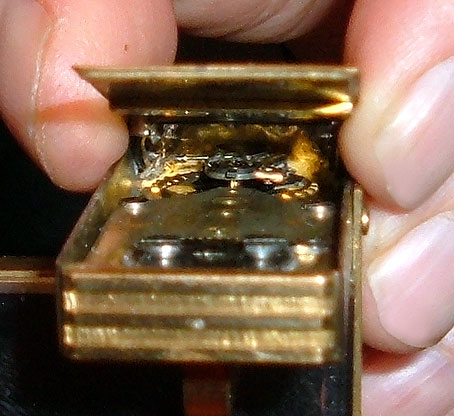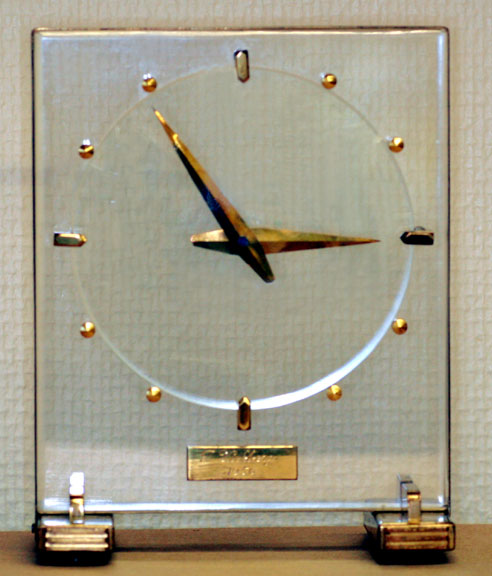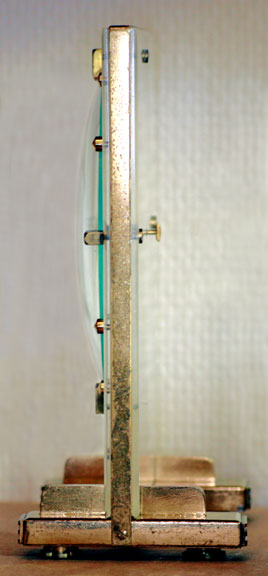Mystery
A Unique Mystery Clock and One of a Kind
By Roger Russell
These pages are copyrighted.
No portion of this site may be reproduced in whole or in part
without written permission of the author.
Here is a mystery clock that is truly original and one-of-a-kind. It demonstrates the ingenuity of one who is a true enthusiast of mystery clocks. Although the principle is similar to the Smith’s of England, Mastercrafters 209 Fantasy clock Chicago, IL or the Haddon Southwind clock, Chicago, IL, the mystery of how this works is even more impressive and enigmatic.
Here is the story told by Borje Vickberg.
I have today (November 7, 2009) received a mystery clock made by my late father, Tuure Vickberg, Gothenburg, Sweden in 1956. The clock, that still works, has been in California for some decades donated by my father to a passionate clock-collector, Ernest Lantz. When he passed away this year his widow contacted me and we have arranged transportation and I must say I am very glad to see it again.
|
|
|
This is the only one ever made. My father constructed it, just for the love of it, in 1956. It was never meant to have commercial applications. It received some attention from the Swedish professional organization for watch-makers that existed then. It is purely mechanical. The mechanism is situated in one of the feet under the clock. From what I understand there are three parallel sheets of Plexiglas, a material new at the time. The sheet in the middle is virtually invisible, rocks once a minute, hence giving an impulse for the hands to move.
The clock is 120 mm (4.7”) from left to right, 150 mm (5.9”) from bottom to top and the thickness is 10 mm (.39”), except for the concave glass piece ( I believe from an alarm-clock) covering the hands. On the brass-plate on the front you can read " T. Vickberg 1956." The clock was called " Vickbergs Mysterie Ur." Even if you don’t know any Swedish you probably understand what it means. The piece in the center of the clock at the rear is to set the time. The hands are made of brass. They just look golden. My father had a tendency to make things of available material. He did not mind to spend numerous hours inventing but he was quite reluctant to spend any excessive Swedish krona buying things that was possible to construct.

Here you get a glimpse of the mechanism. From what I understand the clock-work regularly gives a mechanical impulse to the intermediate and invisible sheet of plastic. When you wind up the clock it will run for three days. It is purely mechanical. The clock-work mechanism was taken from a wrist-watch that he had repaired but the customer never showed up.

The wind knob is at bit of a mystery too. If you look carefully, you can see that underneath each foot there are to small nuts. They all look identical and seem to be put there just to support the clock. One of these is movable and has the function of wind knob.
My father was more or less a self-made man. He was born and grew up in Finland where he started his career as an employed "watch-maker". All is life he was interested in mechanics. Apart from clocks he constructed film projectors for home movie, tape recorders before they where available here in Sweden. The Second World War and his traumatic experiences fighting against Soviet Union brought him to Sweden. In the fifties he set up a store of his own selling watches and clocks plus repairing. I believe he did not have that many customers in the first years; hence he had time to construct the mystery clock. When the technical development changed the business completely (Seiko, quartz etc...) he became an optician. He retired at the age of 70. In the seventies he became an affectionate computer nerd , quite unusual regarding his age. When he finally ended his days in a home for elderly 2005, he was their first guest with cell-phone and internet-connected computer.
|
About This Site |
||
|
|
Any comments, corrections, or additions are welcome All
contents are copyright |
|

